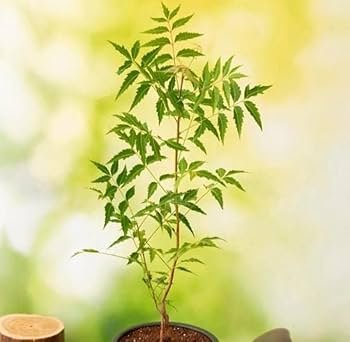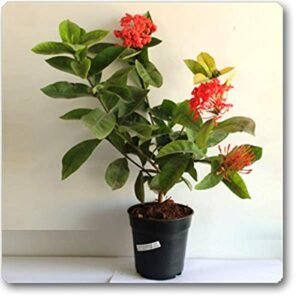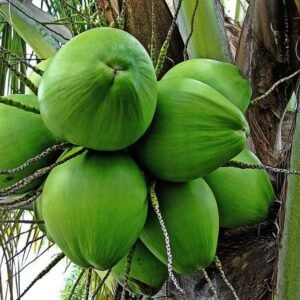Description
Neem Plant (Azadirachta indica) – A Complete Description
Introduction
The Neem plant, scientifically known as Azadirachta indica, is a fast-growing, evergreen tree native to the Indian subcontinent. Revered for its wide range of medicinal, agricultural, and environmental benefits, Neem is often referred to as “the village pharmacy” in India. Almost every part of the tree—leaves, bark, seeds, flowers, and roots—has been used for centuries in traditional medicine, particularly in Ayurveda, Siddha, and Unani systems.
Neem belongs to the Meliaceae family and is closely related to the mahogany tree. The plant thrives in tropical and subtropical regions and is widely cultivated across South Asia, Africa, the Caribbean, and parts of South America due to its drought-resistant nature and multiple uses.
Botanical Description
- Scientific Name: Azadirachta indica
- Family: Meliaceae
- Common Names: Neem (English), Nim (Hindi), Vepa (Telugu), Veppam (Tamil), Bevu (Kannada), Nimba (Sanskrit)
Neem is a medium to large-sized deciduous tree, typically growing 15 to 20 meters in height, though some can reach up to 30 meters. It has a straight trunk with a diameter of 1.5–2.5 meters and a wide, spreading crown.
- Leaves: The leaves are alternate, pinnate with 20–30 medium to dark green leaflets. Each leaflet is lanceolate with a serrated margin and emits a strong aroma.
- Flowers: Neem flowers are small, white to pale yellow, and arranged in drooping panicles. They are fragrant and hermaphroditic, attracting pollinators like bees and butterflies.
- Fruits: The fruit is a smooth, olive-like drupe that turns yellow when ripe. Inside is a single seed that contains valuable Neem oil.
Climatic Requirements and Cultivation
Neem grows best in hot, arid, and semi-arid climates and is known for its resilience in poor, rocky, and dry soils. It thrives in temperatures between 21°C and 32°C and can withstand drought conditions. Though it prefers well-drained soils, it is also found growing in saline, alkaline, and nutrient-poor environments.
Neem trees are generally propagated by seeds, although vegetative propagation is also possible through root cuttings or tissue culture. The plant begins to bear fruit within 3–5 years and reaches full maturity in about 10 years.
Medicinal Properties and Uses
Neem is celebrated globally for its therapeutic properties, many of which are backed by modern science. The major bioactive compounds in Neem include azadirachtin, nimbin, nimbolide, and gedunin—all of which contribute to its medicinal efficacy.
1. Leaves
Neem leaves are rich in antioxidants, flavonoids, and polyphenols. They are widely used for:
- Treating skin disorders like eczema, psoriasis, and acne.
- Controlling blood sugar levels in diabetics.
- Boosting immunity and purifying the blood.
- Acting as a natural insecticide when crushed and applied to wounds or sprayed on plants.
2. Bark
The bark is known for its astringent and anti-inflammatory properties. It is used in:
- Dental care products like toothpaste and mouthwash for treating gingivitis and cavities.
- Decoctions for fevers, malaria, and digestive disorders.
3. Seeds and Oil
Neem seeds yield Neem oil, a powerful product with antibacterial, antifungal, and anti-inflammatory properties. Neem oil is:
- Used in skin and hair care products for dandruff, lice, and acne.
- Applied to wounds and infections.
- A key ingredient in natural pesticides and biopesticides.
4. Flowers
Neem flowers are mildly sweet and have a calming effect. They are:
- Used in teas and infusions for detoxification.
- Eaten in South Indian dishes to stimulate digestion and improve liver function.
Traditional and Cultural Significance
Neem has a prominent place in Indian culture and tradition, often associated with purity, health, and protection. In many Indian households, Neem leaves are hung at the entrance during festivals or used in religious ceremonies to ward off evil spirits and infections.
In Ayurvedic medicine, Neem is considered a “Sarva Roga Nivarini,” meaning “cure for all ailments.” It balances the body’s three doshas—Vata, Pitta, and Kapha—according to Ayurvedic theory.
In rural India, Neem twigs are commonly used as natural toothbrushes or “datun,” which help maintain oral hygiene and strengthen gums.
Agricultural and Environmental Uses
Neem plays a crucial role in sustainable agriculture and environmental conservation:
1. Biopesticide
Azadirachtin, a compound in Neem seeds, disrupts the life cycle of pests by inhibiting their feeding and reproduction. Neem-based insecticides are:
- Biodegradable
- Non-toxic to humans and animals
- Effective against a wide range of pests like aphids, mites, and caterpillars
2. Soil Improvement
Neem cake (the byproduct after oil extraction) is rich in nitrogen, phosphorus, and potassium. It is used as:
- A natural fertilizer
- A soil conditioner that reduces soil alkalinity and improves microbial activity
3. Afforestation and Reclamation
Because of its fast growth and adaptability, Neem is widely planted in afforestation programs and used to reclaim wastelands and degraded soils.
Scientific Research and Modern Applications
Recent studies validate many of Neem’s traditional uses. Its potential applications include:
- Pharmaceuticals: Anti-cancer, anti-diabetic, and antiviral drug development.
- Cosmetics: Inclusion in soaps, creams, shampoos, and lotions.
- Veterinary medicine: Neem oil and extracts are used to treat wounds and parasitic infections in animals.
- Public health: Used in mosquito repellents and fumigants to control vector-borne diseases like malaria and dengue.
Challenges and Considerations
While Neem is generally safe, excessive or prolonged use of concentrated Neem extracts may cause side effects like:
- Skin irritation
- Allergic reactions
- Toxicity in infants if Neem oil is ingested
Proper dosage and consultation with a healthcare provider are advised, especially when used medicinally.
Conclusion
The Neem plant (Azadirachta indica) is truly a miracle tree, offering holistic benefits to human health, agriculture, and the environment. Its extensive use in traditional medicine, combined with modern scientific validation, makes it an invaluable resource for sustainable living. As awareness of natural and eco-friendly practices continues to grow, Neem stands out as a time-tested solution for a healthier planet and population.
Whether it’s purifying the air, healing the skin, or protecting crops, the Neem tree remains a cornerstone of ecological balance and human well-being.





 SINGAPORE IXORA-PLANT (Copy)
SINGAPORE IXORA-PLANT (Copy) 

Reviews
There are no reviews yet.